Skyway
The world's largest discontinuous skyway network – Calgary, Alberta, Canada's "+15 Walkway" system – has a total length of 16 km (9.9 mi).[9] There are significant skyway networks in many cities in the US Midwest, such as Minneapolis, Saint Paul, Des Moines, Cedar Rapids, Rochester, and Duluth.The world's longest pedestrian hanging skywalk, at 430 meters, is the Zhangjiajie Glass Bridge, which sits between mountain peaks in China.The highest cantilevered skybridge as construction element of building exist atop of Kingdom Centre in Riyadh, Saudi Arabia.One of the most famous similar cantilevered skybridges, that looks like uppered[check spelling] ship from the bird's-eye and submarine from the ground, known in Singapore's Marina Bay Sands resort complex of skyscrapers.One of the most impressionable hanging pedestrian skybridges, supported by two giant hands, Golden Bridge now attracts tourists in Ba Na Hills near Da Nang, Vietnam.Common reasons skywalks were built include to avoid street pollution, dust, wetness from food vendors and/or rain, potholes, long queues, crowds, and uneven pavement, supporting urbanism but probably most importantly, tourism receipts.Particularly large networks exists around elevated or at grade MTR stations and connections between malls and housing estates in new town centers.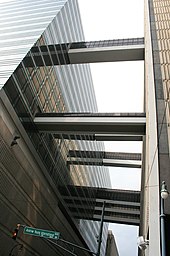
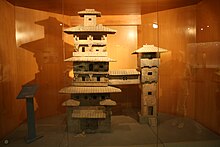
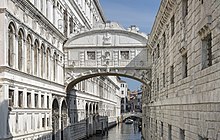
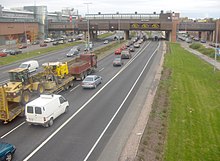
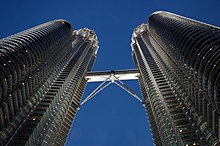
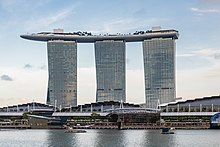
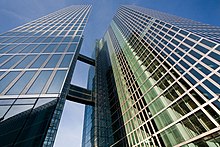
Skyway (disambiguation)Skywalk (disambiguation)SkybridgePeachtree CenterAtlantaHan dynastypedwayurban areaenclosedfootbridgespublic spacessidewalkPetronas Towersshopping malluniversitytunnels+15 WalkwayMinneapolis Skyway SystemMinneapolisMinnesotaUnited StatesterminalsairportsManchester Airportjet bridgesunderground cityBridge of SighsVeniceFlorenceVasari CorridorPalazzo VecchioUffiziPalazzo PittiDoge's PalaceCopenhagenFaaborgItäväylä HighwayItäkeskusHelsinkitraffic congestionvehicular air pollutionvehicular noisecomputer modelsCincinnati SkywalkUS MidwestSaint PaulDes MoinesCedar RapidsRochesterDuluthNew YorkHigh LineAtlanta, GeorgiaArlington, VirginiaRosslynCalgary, Alberta+15, +30, or +45Cedar Rapids, IowaCharlotte, North CarolinaOverstreet MallChicago, IllinoisChicago PedwayDallas, TexasDallas Pedestrian NetworkDes Moines, IowaDetroit, MichiganDuluth, MinnesotaEdmonton, AlbertaEdmonton PedwayFargo, North DakotaGrand Rapids, MichiganHalifax, Nova ScotiaDowntown Halifax LinkHouston, TexasHouston Downtown Tunnel SystemIndianapolis, IndianaIndiana Convention CenterIndianapolis ArtsgardenLucas Oil StadiumCircle Centre MallIndianapolis Union StationJW Marriott IndianapolisKansas City, MissouriCrown CenterLas Vegas StripLincoln, NebraskaLos Angeles, CaliforniaCalvin S Hamilton PedwayLouisville, KentuckyMankato, MinnesotaMilwaukee, WisconsinMilwaukee SkywalkThe AvenueHyatt RegencyBaird CenterChase TowerEmpire Building100 East WisconsinHilton Milwaukee City CenterMinneapolis, Minnesotalinear parkHudson YardsOne Manhattan WestOklahoma City, OklahomaOklahoma City UndergroundPittsburgh, PennsylvaniaRochester, New YorkSaint Paul, MinnesotaSioux City, IowaSpokane, WashingtonToronto, OntarioSkyWalkMetro Toronto Convention CentreUnion Station (Toronto)Winnipeg, ManitobaWinnipeg WalkwayKuala LumpurMarina Bay SandscantileveredRaffles City ChongqingChongqingZhangjiajie Glass BridgeKingdom CentreRiyadhSaudi ArabiaPetronas Twin Towers